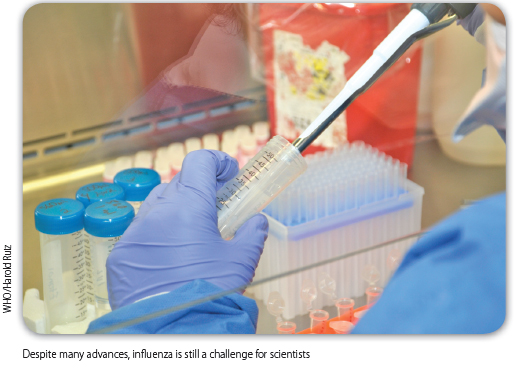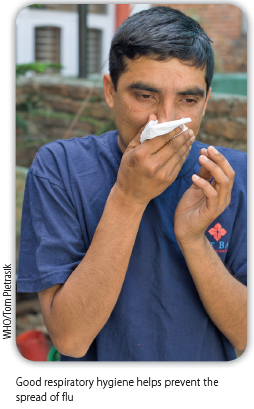NEWS
The influenza enigma
Recent advances in microbiology and molecular sequencing have vastly improved our understanding of how human influenza viruses evolve and spread. But several unanswered questions continue to vex researchers. Patrick Adams reports.
To disease detectives at the world's leading public health agencies, influenza is an all-too familiar foe. First isolated in 1932, the virus - a single-stranded member of the orthomyxovirus family - occurs every year in every country, seasonally and sporadically, killing between 250000 and 500000 people and causing severe illness in several million more, according to the World Health Organization (WHO).
Over the past three centuries, there have been at least 10 global influenza pandemics and three in the last century alone, among them the so-called 'Spanish flu' of 1918-1919. The single most devastating disease outbreak in human history, that pandemic is believed to have caused between 20 million and 50 million deaths worldwide. It is the prospect of another such catastrophe, and the staggering toll of seasonal flu, that has made influenza the world's second-most studied virus, behind HIV.
In recent years, those investments in influenza research have yielded important new insights about the virus's genetic makeup and capacity for mutation. Indeed, with the reconstruction of the 1918 virus at the US Centers for Disease Control and Prevention (CDC) in Atlanta in 2005, scientists were able to identify the genetic changes that allowed the virus to cross the species barrier between birds and humans, confirming fears that the avian H5N1 strain that has been circulating in Asia could one day do the same.
Now, at two leading influenza laboratories at the University of Wisconsin-Madison, in the United States of America (USA) and Erasmus MC in Rotterdam, the Netherlands, researchers have broken new ground by creating mutant H5N1 strains. The controversial studies, which have been paused for a debate over the risks they may pose to public health, demonstrate that viruses equipped with a haemagglutinin protein from highly pathogenic H5N1 viruses can become transmissible in ferrets.
Ferrets are believed to be the ideal small animal model for influenza because they are susceptible to human flu viruses and some of the symptoms seen in humans. It is not yet known whether this mutant H5N1 is transmissible in humans and a study to find that out would probably not be possible. But we can infer that there is a high likelihood of transmissibility based on the findings in ferrets.
Yet for all of the advances afforded by new genomic technologies, our understanding of the fundamental epidemiology of influenza remains far from complete. "Such broad questions as what specific forces direct the appearance and disappearance of epidemics still challenge virologists and epidemiologists," wrote the late, long-serving CDC epidemiologist Michael Gregg in 1980. This is still the case today.

Take, for example, the enduring enigma of influenza seasonality. The clock-like consistency of the virus's winter incidence, which peaks in temperate zones, provides perhaps the most striking illustration of seasonality in infectious diseases. However, clouding the picture is the highly variable pattern of seasonal flu outbreaks in the tropics, says US National Institutes of Health (NIH) epidemiologist Martha Nelson. "They can be associated with rainy seasons or dry seasons, and you could have one epidemic or two epidemics," she says. "It's really not well understood."
This despite several untested and inconclusive theories being put forward as to why this is the case.
Similarly puzzling is the question of where those seasonal strains come from. Although it has long been held that south-east and eastern Asia are the global source of seasonal flu epidemics, a recent study by researchers at the Duke-National University of Singapore (NUS) Graduate Medical School casts considerable doubt on that assumption. Published last November in the journal Proceedings of the National Academy of Sciences, the study compared viral migration between urban centres in seven different temperate and tropical regions between 2003 and 2006. And in none of the years studied could all of the new flu strains be traced back to a single region.
"We found that it's a dynamic system," says Gavin Smith, a molecular epidemiologist at Duke-NUS and the senior author of the study. "Rather than a single source, you have a number of local epidemics that overlap in time and feed into one another." Though the data set isn't globally representative, he says, larger studies in the future could offer a glimpse of what virus dissemination patterns might look like in a pandemic. "If you knew how the virus enters, say, South America, you could tailor interventions to prevent that."

Another glaring gap in influenza epidemiology, say experts, is the dearth of surveillance data on influenza in domestic and wild animal populations, particularly birds and pigs.
"We need to learn more about which of the viruses circulating in those populations we need to be worried about," says Richard Webby, a flu virologist at the St Jude Children's Research Hospital in Memphis, Tennessee, in the USA.
Webby notes that, while in 2009 surveillance efforts were focused on avian viruses in Africa and Asia, it was through pigs in the Americas that H1N1 went pandemic. With receptors for both human and avian viruses, pigs can serve as 'mixing vessels' for the recombination of different viruses' genomic material. This phenomenon, known as reassortment, can produce novel strains with pandemic potential.
Already, pandemic H1N1 viruses are reassorting with H3N2 viruses in swine to create variant H3N2 (H3N2v) viruses that have infected 12 humans in the USA since July 2011, with limited human-to-human transmission and posing a potential pandemic threat.
Albert Osterhaus, head of the department of virology at Erasmus MC and a co-author on the mutant H5N1 study, agrees. "Monitoring birds is very important," he says, "but we should be doing much more work on influenza in pigs. We know the numbers are huge and we don't know what exactly is happening there." A veterinarian turned virologist, Osterhaus's research team was the first to show, in 1997, that H5N1 is transmissible to humans from birds. Since then, he's sounded the alarm for pandemic preparedness, calling for closer monitoring of bird populations, greater uptake of existing vaccines and the creation of a global database that integrates information on both animal and human influenzas.
Adding to concerns about animal influenza is the increasing intensification of south-east Asia's agriculture and farming sectors, both of which have experienced enormous growth in recent decades. "We're in a different world now," says Richard Coker, director of the Bangkok-based Communicable Diseases Policy Research Group. "A lot more virus mixing, greater potential for reassortment and greater selection pressures" - all of which, he says, seem to have raised the risk of a new pandemic.
"We don't know, for example, if industrial poultry production generates new viruses or simply acts as an amplifier for the viruses that enter those systems." If we knew this, says Coker, we could focus surveillance activities more effectively and design food systems better, making them more secure. Compounding the problem, he adds, are issues of equitable access to drugs and vaccines and the investments in health systems that might be needed to mitigate threats posed by an outbreak. "The big overarching question is when you have scarce resources globally, which countries and which peoples benefit? Right now, we don't have a mechanism to address this."
While opinions differ on where best to focus scarce resources, experts agree on the prime importance of a universal vaccine. "Having a highly protective agent against multiple strains would clearly be a game-changer," says Michael Osterholm, director of the Center for Infectious Disease Research and Policy at the University of Minnesota. "It would fundamentally change the whole picture." Moreover, given the backlog of what he calls "potentially outstanding candidates," it's also a realistic goal.
"We have the science," he says. "But no one is prepared to take a candidate vaccine across the 'valley of death'- from Phases I and II to Phase III to licensure." Osterholm attributes the problem to a general misconception about currently available vaccines, the benefits of which, he argues, have been grossly oversold. "They're not nearly as effective as we've told the public they are," he says, and he backs that claim with the findings of a meta-analysis he and colleagues conducted last year.
Using highly restrictive criteria, Osterholm and three other influenza researchers screened more than 5700 studies of the efficacy of vaccines licensed in the USA that had been published since the 1960s. From 31 eligible studies - only those whose endpoints were laboratory-confirmed influenza - they found that on average the seasonal flu vaccine was about 59% effective in individuals aged 18 to 65 years - far lower than the 70-90% previously believed - with at best a 4% reduction in mortality among the elderly. In this case 'effective' meant able to prevent laboratory-confirmed influenza, regardless of severity. The study was published in Lancet Infectious Diseases.
While Osterholm acknowledges that public health officials face a difficult challenge in convincing an already wary public of the merits of vaccination, he says that at the end of the day public health has one requirement: "Tell the truth. Just tell the truth. We have not been forthright with our public or our medical professionals about just how effective this vaccine really is." 
